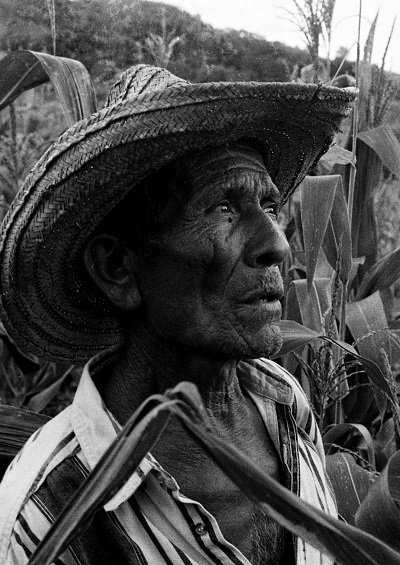Corn Provides Life in Nicaragua
Farmers in Nicaragua still subsist off corn, the crop that made civilization possible in Mesoamerica.
January 10, 2016

Richard Leonardi is a US-born freelance photographer based in Nicaragua since 1996. His photographic work has been published in Europe, Latin America and the US.
As with rice in Asia and wheat in the Middle East, corn made civilization possible in Mesoamerica and is still a vital element of life in Nicaragua’s countryside. Most families farm small plots of corn whose harvests, after being dried and stored, feed them for the rest of the year.
Juan has planted corn in this mountainous region of northwestern Nicaragua since he was a boy. He still works six days a week. Born around 20 miles away, he has worked his current plot for 45 years.
Every day during the year’s two planting seasons – May-July and August-October – he makes the 30-minute climb up a steep hillside to tend to his crop, which yields enough corn for him to sell part of his harvest for cash. He also grows beans which he plants once a year and raises a few cattle.
Three of Juan’s sons and five of his grandchildren live with him and his wife, but many of his relatives have emigrated to Costa Rica, Spain or the United States. In 2006, an electricity supply was installed in his home, and since then he has also added a latrine and a well.
Although illiterate, he has a rich knowledge of the names and life-cycles of around 100 different trees and shrubs in his area.
Text and photographs by Richard Leonardi
Sustenance farmer Juan Pichardo, 68, in a field of his corn near the town of El Jicaral in Nicaragua’s León state.
 Richard Leonardi is a US-born freelance photographer based in Nicaragua since 1996. His photographic work has been published in Europe, Latin America and the US.
Richard Leonardi is a US-born freelance photographer based in Nicaragua since 1996. His photographic work has been published in Europe, Latin America and the US.The Other Hundred is a unique photo-book project (order here) aimed as a counterpoint to the Forbes 100 and other media rich lists by telling the stories of people around the world who are not rich but who deserve to be celebrated.
Its 100 photo-stories move beyond the stereotypes and cliches that fill so much of the world’s media to explore the lives of people whose aspirations and achievements are at least as noteworthy as any member of the world’s richest 1,000.
 Selected from 11,000 images shot in 158 countries and submitted by nearly 1,500 photographers, The Other Hundred celebrates those who will never find themselves on the world’s rich lists or celebrity websites.
Selected from 11,000 images shot in 158 countries and submitted by nearly 1,500 photographers, The Other Hundred celebrates those who will never find themselves on the world’s rich lists or celebrity websites.Takeaways
As with rice in Asia and wheat in the Middle East, corn made civilization possible in Mesoamerica.
Juan has planted corn in this mountainous region of northwestern Nicaragua since he was a boy.
Farmers in Nicaragua still subsist off corn, the crop that made civilization possible in Mesoamerica.





